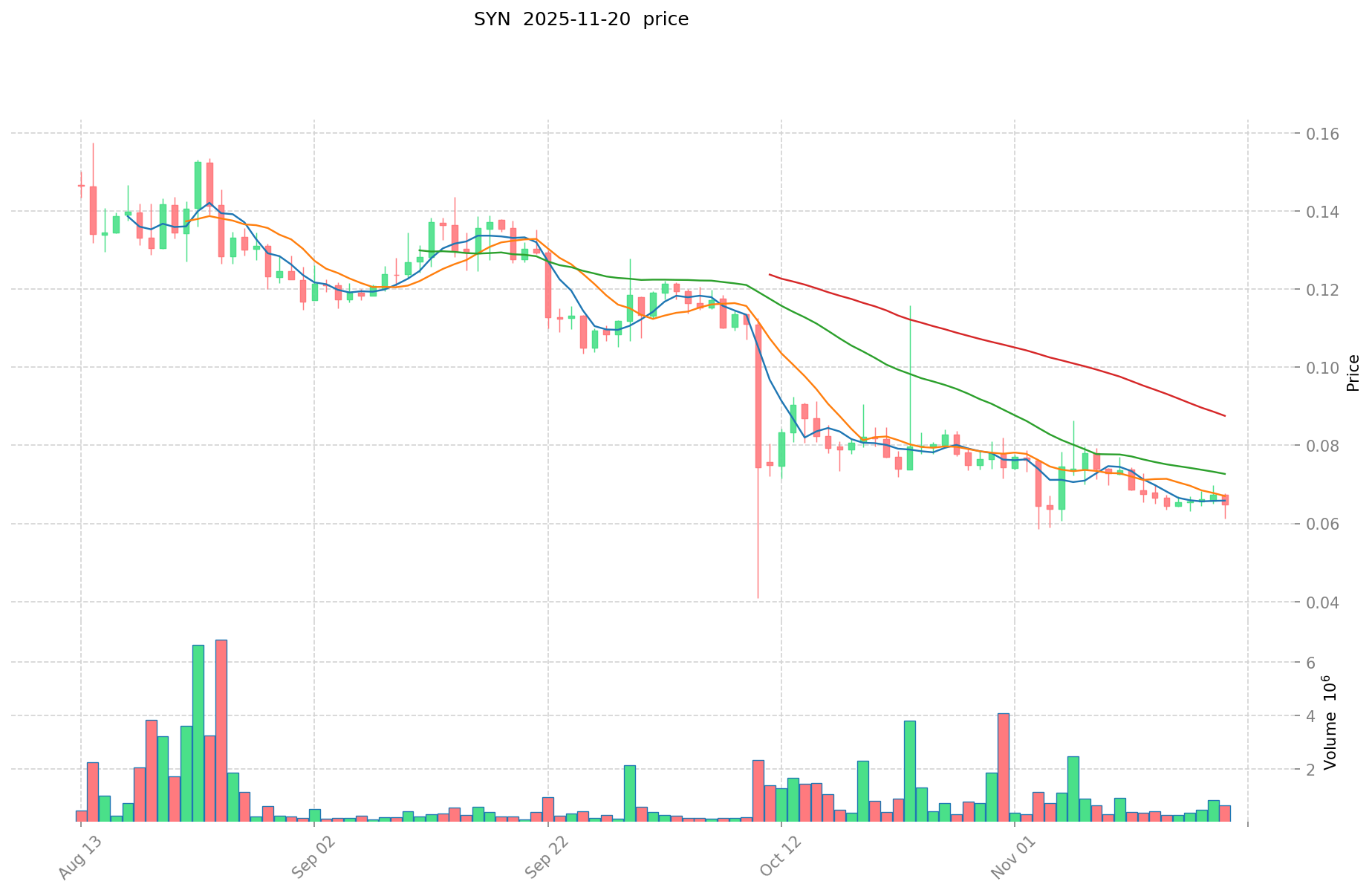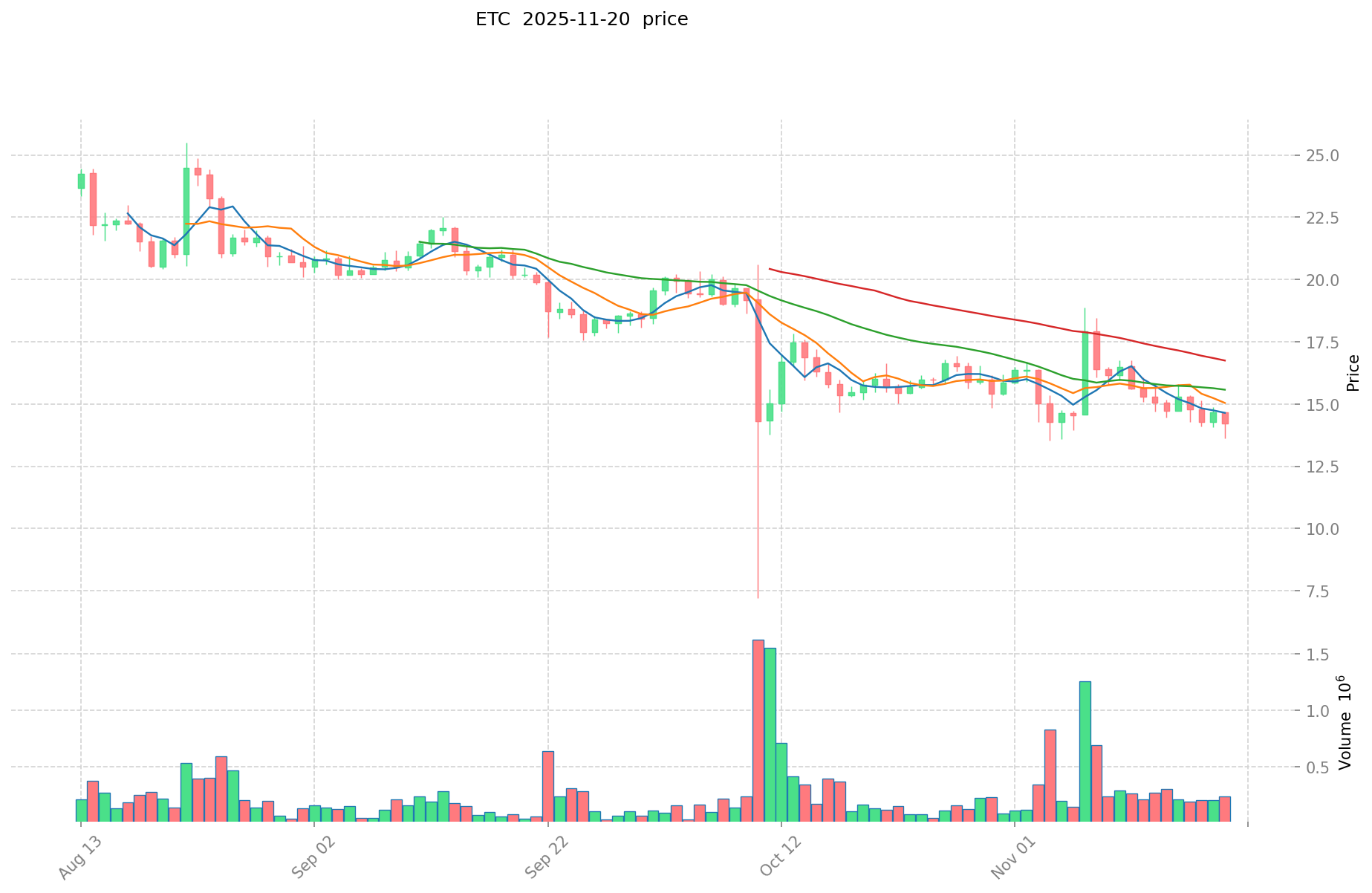SYN vs ETC: Comparing Synthetic and Exchange-Traded Commodities in Modern Investment Strategies
Introduction: Investment Comparison of SYN vs ETC
In the cryptocurrency market, the comparison between Synapse (SYN) and Ethereum Classic (ETC) has been an unavoidable topic for investors. The two not only show significant differences in market cap ranking, application scenarios, and price performance, but also represent different positions in the crypto asset landscape.
Synapse (SYN): Since its launch, it has gained market recognition for its cross-chain interoperability protocol.
Ethereum Classic (ETC): Since 2016, it has been hailed as a continuation of the original Ethereum blockchain, adhering to the "code is law" principle.
This article will comprehensively analyze the investment value comparison between SYN and ETC, focusing on historical price trends, supply mechanisms, institutional adoption, technological ecosystems, and future predictions, attempting to answer the question investors care about most:
"Which is the better buy right now?"
I. Price History Comparison and Current Market Status
SYN and ETC Historical Price Trends
- 2021: SYN reached its all-time high of $4.92 on October 24, 2021.
- 2021: ETC hit its all-time high of $167.09 on May 7, 2021.
- Comparative analysis: SYN has fallen from its peak of $4.92 to a current price of $0.06564, while ETC has dropped from $167.09 to $14.289.
Current Market Situation (2025-11-20)
- SYN current price: $0.06564
- ETC current price: $14.289
- 24-hour trading volume: SYN $47,180.11 vs ETC $2,984,567.26
- Market Sentiment Index (Fear & Greed Index): 11 (Extreme Fear)
Click to view real-time prices:
- View SYN current price Market Price
- View ETC current price Market Price


II. Core Factors Affecting Investment Value of SYN vs ETC
Supply Mechanism Comparison (Tokenomics)
- SYN: Implements deflationary tokenomics with a fee-burning mechanism that reduces supply over time
- ETC: Fixed supply cap of 210.7 million coins with a decreasing block reward structure, similar to Bitcoin's model
- 📌 Historical Pattern: Deflationary assets like SYN tend to create upward price pressure when adoption increases, while ETC's fixed supply model provides predictable scarcity that historically supports long-term value preservation.
Institutional Adoption and Market Applications
- Institutional Holdings: ETC has greater institutional recognition through Grayscale's ETC Trust and inclusion in more regulated investment products
- Enterprise Adoption: ETC has established integration with IoT applications and cross-chain interoperability projects, while SYN focuses on cross-chain interoperability for DeFi applications
- Regulatory Attitudes: ETC benefits from regulatory clarity as a legacy chain, while SYN operates in a more ambiguous regulatory environment as a newer cross-chain protocol
Technical Development and Ecosystem Building
- SYN Technical Upgrades: Recently implemented Optimistic Bridge technology to reduce cross-chain transaction costs and verification times
- ETC Technical Development: Maintaining compatibility with Ethereum while preserving immutability principles; focusing on stability over rapid innovation
- Ecosystem Comparison: ETC maintains a more established but slower-growing ecosystem focused on value storage and legacy applications, while SYN is rapidly expanding its DeFi integrations across multiple chains including Ethereum, BSC, and Avalanche
Macroeconomic Factors and Market Cycles
- Inflation Performance: ETC has positioned itself as "digital silver" with hard-cap supply, demonstrating stronger correlation with traditional inflation hedges
- Monetary Policy Impact: Both assets show sensitivity to Federal Reserve policy changes, with ETC historically showing higher correlation with broader crypto market movements
- Geopolitical Factors: ETC benefits from established global trading infrastructure, while SYN's cross-chain functionality potentially offers advantages during periods of geopolitical instability
III. 2025-2030 Price Prediction: SYN vs ETC
Short-term Prediction (2025)
- SYN: Conservative $0.046 - $0.066 | Optimistic $0.066 - $0.085
- ETC: Conservative $8.99 - $14.27 | Optimistic $14.27 - $19.98
Mid-term Prediction (2027)
- SYN may enter a growth phase, with prices estimated between $0.069 - $0.106
- ETC may enter a bullish market, with prices estimated between $19.22 - $28.21
- Key drivers: Institutional capital inflow, ETF, ecosystem development
Long-term Prediction (2030)
- SYN: Base scenario $0.105 - $0.122 | Optimistic scenario $0.122 - $0.125
- ETC: Base scenario $24.28 - $30.35 | Optimistic scenario $30.35 - $39.15
Disclaimer
SYN:
| 年份 | 预测最高价 | 预测平均价格 | 预测最低价 | 涨跌幅 |
|---|---|---|---|---|
| 2025 | 0.085436 | 0.06572 | 0.046004 | 0 |
| 2026 | 0.1095881 | 0.075578 | 0.07255488 | 15 |
| 2027 | 0.1064705075 | 0.09258305 | 0.068511457 | 41 |
| 2028 | 0.1224179378625 | 0.09952677875 | 0.0746450840625 | 51 |
| 2029 | 0.132057106384437 | 0.11097235830625 | 0.068802862149875 | 69 |
| 2030 | 0.125160174315704 | 0.121514732345343 | 0.104502669816995 | 85 |
ETC:
| 年份 | 预测最高价 | 预测平均价格 | 预测最低价 | 涨跌幅 |
|---|---|---|---|---|
| 2025 | 19.9822 | 14.273 | 8.99199 | 0 |
| 2026 | 24.663744 | 17.1276 | 13.530804 | 19 |
| 2027 | 28.2091572 | 20.895672 | 19.22401824 | 46 |
| 2028 | 34.37338044 | 24.5524146 | 13.258303884 | 71 |
| 2029 | 31.2306713712 | 29.46289752 | 19.150883388 | 106 |
| 2030 | 39.147351934824 | 30.3467844456 | 24.27742755648 | 112 |
IV. Investment Strategy Comparison: SYN vs ETC
Long-term vs Short-term Investment Strategies
- SYN: Suitable for investors focused on cross-chain interoperability and DeFi ecosystem potential
- ETC: Suitable for investors seeking stability and inflation-resistant properties
Risk Management and Asset Allocation
- Conservative investors: SYN: 20% vs ETC: 80%
- Aggressive investors: SYN: 60% vs ETC: 40%
- Hedging tools: Stablecoin allocation, options, cross-currency portfolios
V. Potential Risk Comparison
Market Risk
- SYN: Higher volatility due to smaller market cap and newer protocol
- ETC: Vulnerability to overall crypto market sentiment and legacy chain competition
Technical Risk
- SYN: Scalability, network stability, and potential vulnerabilities in cross-chain bridges
- ETC: Mining centralization, security vulnerabilities inherited from Ethereum
Regulatory Risk
- Global regulatory policies may have different impacts on both assets, with ETC potentially facing less scrutiny due to its established status
VI. Conclusion: Which Is the Better Buy?
📌 Investment Value Summary:
- SYN advantages: Cross-chain interoperability, growing DeFi ecosystem, deflationary tokenomics
- ETC advantages: Established network, fixed supply cap, institutional recognition
✅ Investment Advice:
- New investors: Consider a smaller allocation to SYN for higher risk/reward, larger allocation to ETC for stability
- Experienced investors: Balance portfolio with both assets, adjusting based on risk tolerance and market conditions
- Institutional investors: ETC may be more suitable due to regulatory clarity and established market presence
⚠️ Risk Warning: The cryptocurrency market is highly volatile, and this article does not constitute investment advice. None
VII. FAQ
Q1: What are the main differences between SYN and ETC in terms of investment potential? A: SYN offers potential in cross-chain interoperability and DeFi ecosystem growth, with deflationary tokenomics. ETC provides stability, a fixed supply cap, and stronger institutional recognition as a legacy chain.
Q2: Which asset has shown better price performance historically? A: ETC reached a higher all-time high of $167.09 in May 2021, compared to SYN's peak of $4.92 in October 2021. However, both have seen significant drops from their peaks, with SYN currently at $0.06564 and ETC at $14.289.
Q3: How do the supply mechanisms of SYN and ETC differ? A: SYN implements a deflationary tokenomics model with a fee-burning mechanism, while ETC has a fixed supply cap of 210.7 million coins with a decreasing block reward structure similar to Bitcoin.
Q4: What are the key factors influencing the future price predictions for SYN and ETC? A: Key drivers include institutional capital inflow, potential ETF approvals, ecosystem development, macroeconomic factors, and technological advancements in their respective networks.
Q5: How do SYN and ETC compare in terms of institutional adoption? A: ETC has greater institutional recognition through products like Grayscale's ETC Trust and inclusion in regulated investment vehicles. SYN, being newer, has less institutional adoption but is growing in the DeFi space.
Q6: What are the main risks associated with investing in SYN and ETC? A: SYN faces higher volatility due to its smaller market cap and newer protocol, as well as potential technical risks in cross-chain bridges. ETC is vulnerable to overall crypto market sentiment and faces competition from other legacy chains, along with potential mining centralization issues.
Q7: How should investors approach allocating between SYN and ETC in their portfolios? A: Conservative investors might consider allocating 20% to SYN and 80% to ETC, while aggressive investors could opt for 60% SYN and 40% ETC. The exact allocation should be based on individual risk tolerance and market conditions.
Share
Content